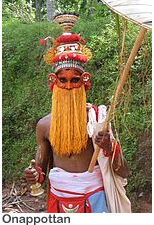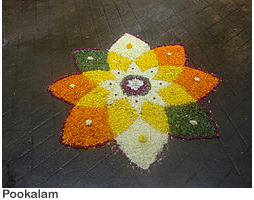
| New Arrivals |
Onam
Onappottan, in traditional costume is a custom in northern parts of Kerala.Onappottan visits houses during the onam and gives blessings. Of late onappottanhas become a rare sight, confined to villages. The celebrations of Onam start on Atham day, 10 days before Thiruvonam. The 10 days are part of the traditional Onam celebrations and each day has its own importance in various rituals and traditions. Earthen mounds, which look somewhat like square pyramids, representing Mahabali and Vamana are placed in the dung-plastered courtyards in front of the house and beautifully decorated with flowers. Known as ‘Onapookkalam’, it is a carpet made out of the gathered blossoms with one or two varieties of foliage of differing tints pinched up into little pieces to serve the decorator's purpose. It is considered a work of art accomplished with a delicate touch and a highly artistic sense of tone and blending. (In a similar manner North Indians make Rangoli which is made of powders of various colors.) When completed, a miniature pandal, hung with little festoons is erected over it. Atham- The first day of Onam CelebrationsOnam starts with Atham day in the Malayalam month of Chingam. It is believed that King Mahabali starts his preparations to descend from hell to Kerala on this day. The day also marks the start of festivities at Thrikkakara Temple (considered as the abode of Mahabali). The Onam celebrations across the state, starts off with a grand procession at Thrippunithura near Kochi called Athachamayam. In olden days, the Kochi Maharaja used to head a grand military procession in full ceremonial robes from his palace to the Thrikkakara Temple. After independence, the public took over the function and celebrated as a major cultural procession which kicks off the official celebrations of Onam. Elephant processions, folk art presentations, music and dancing make Athachamyam a spectacular event which is now aggressively promoted as a tourist event. 
The traditional ritual of laying Pookalam (floral carpet) starts on Atham day. The size of pookalam on this day is called as Athapoo and will small which eventually grew day after day. Only yellow flowers will be used on this day and the design will be simple. Also the statues of Mahabali and Vamanan will be installed on the entrance of each house on this day. Onam comes in the month of "Chingam" which is the first month according to the Malayalam Calendar. People put flower mats in front of their houses, to welcome King Mahabali. There will be competition for the laying of flower mats; Keralites all over the world will be celebrating this ten days with pomp and gaiety. They wear new dresses, visit as many temples as they can, perform dances like Thiruvadhira kali Thumbi Tullal etc. to name a few. Onam is celebrated with a focus on different cultural aspects at different places. Athachamayam- a cultural procession takes place in the royal town of Tripunithura near Ernakulam-Kochi, on the Atham day of Chingam, which also marks the beginning of Onam celebrations. At theVamanamoorthy temple in Thrikkakara, the annual temple festival coincides with Onam. The temple is dedicated to Lord Vamana and is directly linked to the mythological background of Onam. Onam Pookkalam is considered as a symbol for secularism. Various kinds of flowers combine together to form a great-looking pookkalam. So, it shall reflect those old good days during King Mahabali. It's a great pleasure for people in Kerala to make Pookkalam from Atham to Thiruvonam, especially for children. The celebrations begin within a fortnight of the Malayalam New Year and go on for ten days. The last day called the Thiruvonam is the most important. All over the state, rituals along with new clothes, traditional cuisine, dance, and music mark this harvest festival. At Valluvanad(mainly Ottapalam, Shornur regions), Kathakali dancers in gorgeous costumes enact the legends. A strikingly impressive procession of caparisoned elephants is taken out at Thrissur, where masked dancers also go from house to house performing the colorful Kummattikali dance. At Cheruthuruthy, people gather to watch Kathakali performers enact scenes from epics and folk tales. Pulikali, also known as Kaduvakali is a common sight during Onam season. Performers painted like tigers in bright yellow, red and black, dance to the beats of instruments like Udukkuand thakil. At Aranmula, during Onam days the famous Aranmula Vallam Kali is conducted. The swing is another integral part of Onam, especially in the rural areas. Young men and women, decked in their best, sing Onappaatt, or Onam songs, and rock one another on swings slung from high branches |
